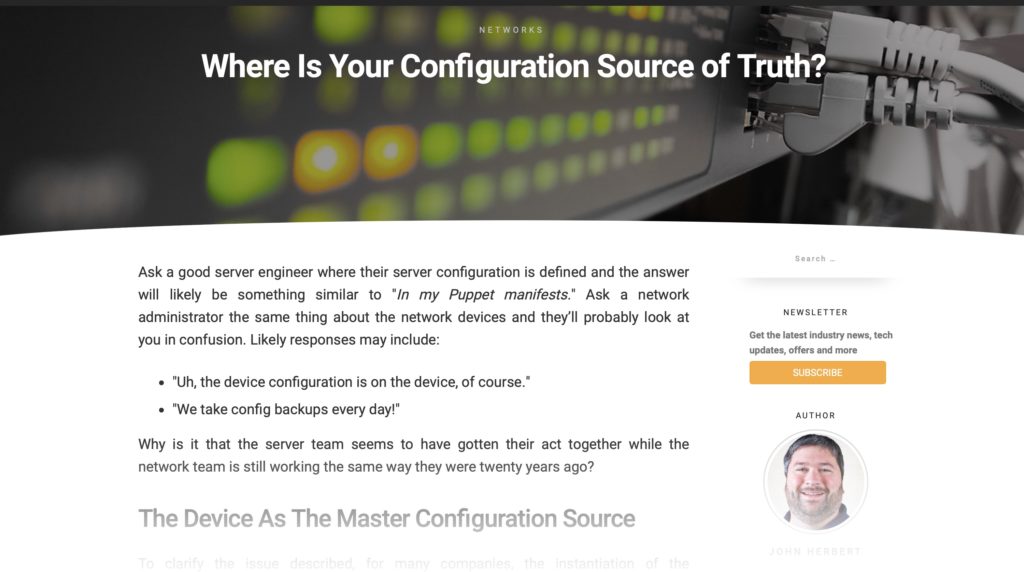Orange Matter: Where is Your Configuration Source of Truth?

I’ve been blogging for Solarwinds recently, posting on Orange Matter, with a cross-post to the Thwack Geek Speak forum. The post linked here looks at where we define our source of truth for device configurations; is it the device itself? Should it be? This is a key question when looking at automation, and one we should all be asking ourselves.
This post appeared on Orange Matter as “Where Is Your Config Source of Truth?“, but I’m also linking to the version posted on Thwack, mainly because that format allowed me to use more images and be slightly more irreverent, which is perhaps a bit more in character.

I’d love it if you were to take a moment to visit and read, and maybe even comment!
If you liked this post, please do click through to the source at Orange Matter: Where is Your Configuration Source of Truth? and give me a share/like. Thank you!
What Makes IoT A Security Risk?

IoT security is a pretty hot topic in today’s world. That’s because the increasing number of smart devices is causing issues with security professionals everywhere. Consumer IoT devices are expected to top 20 billion by 2020. And each of these smart devices represents an attack surface. Or does it?
Hello, Dave
Adding intelligence to a device increases the number of ways that it can compromised. Take a simple thermostat, for example. The most basic themostat is about as dumb as you can get. It uses the expansion properties of metal to trigger switches inside of the housing. You set a dial or a switch and it takes care of the rest. Once you start adding things like programmability or cloud connection, you increase the number of ways that you can access the device. Maybe it’s a webpage or an app. Maybe you can access it via wireless or Bluetooth. No matter how you do it, it’s more available than the simple version of the thermostat.
What about industrial IoT devices? The same rule applies. In this case, we’re often adding remote access to Supervisory Control And Data Acquistion (SCADA) systems. There’s a big market from enterprise IT providers to create Continue reading
What does 2019 have in Store for Cloud and Unified Communications?
The new year will see an appetite for unified communications solutions grow as customer expectations increase in today’s “always available from anywhere” business environment.
SD-WAN Reality Gap
Here’s some feedback I got from a subscriber who got pulled into an SD-WAN project:
I realized (thanks to you) that it’s really important to understand the basics of how things work. It helped me for example at my work when my boss came with the idea “we’ll start selling SD-WAN and this is the customer wish list”. Looked like business-as-usual until I realized I’ve never seen so big a difference between reality, customer wishes and what was promised to customer by sales guys I never met. And the networking engineers are supposed to save the day afterwards…
How did your first SD-WAN deployment go? Please write a comment!
Network Lab Base
Vendor neutral base network lab.Network Lab Base
Most of the labs I build are for learning purposes and I find that I burn a lot of time doing boilerplate tasks and not actually working on the feature(s) im trying to test. I wanted to build a lab where I could chop and change device types from the same vendor ie: Juniper vSRX and vMX...Verizon Gets Frisky in 5G Feud With AT&T
 Verizon's CTO implores the 5G ecosystem to not confuse customers by using the 5G label on networks that do not use 5G technology.
Verizon's CTO implores the 5G ecosystem to not confuse customers by using the 5G label on networks that do not use 5G technology.
Chiplets: The Way to Beat Moore’s Law?
 First came the disaggregation of software from hardware. Now comes the disaggregation of functions on a chip.
First came the disaggregation of software from hardware. Now comes the disaggregation of functions on a chip.
AT&T, Nokia Tighten 5G Focus on O-RAN, Akraino
 The specific work is on developing a software platform for the RAN Intelligent Controller. That platform code will accelerate the deployment of open source software for the 5G radio access network.
The specific work is on developing a software platform for the RAN Intelligent Controller. That platform code will accelerate the deployment of open source software for the 5G radio access network.
Alibaba Buys Open Source Big Data Firm Data Artisans for $130M
 Alibaba has been one of the largest contributors and users of Data Artisans’ open source data processing framework since 2016.
Alibaba has been one of the largest contributors and users of Data Artisans’ open source data processing framework since 2016.
GitHub Rolls Out First Major Update Post-Microsoft Acquisition
 The updates include free access to private repositories that are targeted at small developer teams, and a combination of its cloud and on-premises enterprise offerings.
The updates include free access to private repositories that are targeted at small developer teams, and a combination of its cloud and on-premises enterprise offerings.
rule 11 reader 2019-01-08 18:00:14
Rahul joins Donald and I on the History of Networking at the Network Collective to talk about the history of eVPNs.
Outro Music:
Danger Storm Kevin MacLeod (incompetech.com)
Licensed under Creative Commons: By Attribution 3.0 License
http://creativecommons.org/licenses/by/3.0/
Intel, Facebook Develop New AI Chips
 The chip giant also unveiled 10nm silicon for data center servers and 5G wireless access base stations and at a CES 2019 news conference.
The chip giant also unveiled 10nm silicon for data center servers and 5G wireless access base stations and at a CES 2019 news conference.
GSMAi Consumer Survey Ratchets Down the 5G Hype
 As 5G hype builds, a new report aims to dampen the mood with a cautionary warning that some consumers are not yet that enthused about the innovative services 5G may bring.
As 5G hype builds, a new report aims to dampen the mood with a cautionary warning that some consumers are not yet that enthused about the innovative services 5G may bring.
South Africa Gauteng Community Outreach: Why Community Networks Matter

On 14 December 2018, the young and old people of Mamaila Tribal Authority convened at Wholesale Village in the Limpopo Province in South Africa to learn about community networks (CNs). The workshop, with the theme Why Community Networks Matter, took place at Moratabatho Missionary Church International, and was organized by the Internet Society South Africa Gauteng Chapter and supported by the Beyond the Net Funding Programme. The purpose was to create awareness about community networks as innovative solutions that contribute towards closing the digital divides experienced by communities that lack access to telecommunication infrastructure. The workshop was delivered in partnership with Soweto Wireless User Group (SOWUG) and the Zuri Foundation. Thato Mfikwe, the president of the South Africa Gauteng Chapter, introduced participants to the Internet ecosystem and the opportunities available within the Internet value chain. The presentation by Thato stimulated a conversation with participants curious to know how to:
- Make money from the Internet, specifically how to monetize their content on YouTube
- Participate in the Internet ecosystem
- Contribute to policy making
The session introduced participants to cybersecurity, the Internet of Things (IoT) concepts, and the basic infrastructure required for setting up a community network. The presentation created curiosity among Continue reading
Cuba’s New 3G Service, Six Years After ALBA-1

Last month, ETECSA (Cuba’s state telecom) activated national 3G mobile service. For the first time in the nation’s history, a very modest level of internet service is now available to anyone on the island with a 3G-capable device and the funds to pay for it (i.e., 45cuc per month or almost twice the monthly salary of a Cuban state worker).
The development was announced in a tweet from Cuba’s new president Miguel Díaz-Canel and came almost six years since the activation of the ALBA-1 submarine cable connecting Cuba to the global internet via Venezuela.
Hoy martes el Ministro de Comunicaciones anunciará y explicará en la Mesa Redonda el servicio de Internet en los teléfonos. Seguimos avanzando en la informatización de la sociedad #SomosContinuidad #SomosCuba
— Miguel Díaz-Canel Bermúdez (@DiazCanelB) December 4, 2018
The activation of Cuba’s mobile internet service appeared in our Internet Intelligence Map as a dramatic increase in the number of authoritative DNS queries handled by Dyn’s servers, as we tweeted below.
Last week Cuba rolled out its first nationwide mobile internet service. DNS query volume up for Cuba, visible on @Oracle @Internetintel map. https://t.co/tOpkt7hME7 pic.twitter.com/i0uKS2nk7u
— InternetIntelligence (@InternetIntel) December 10, 2018